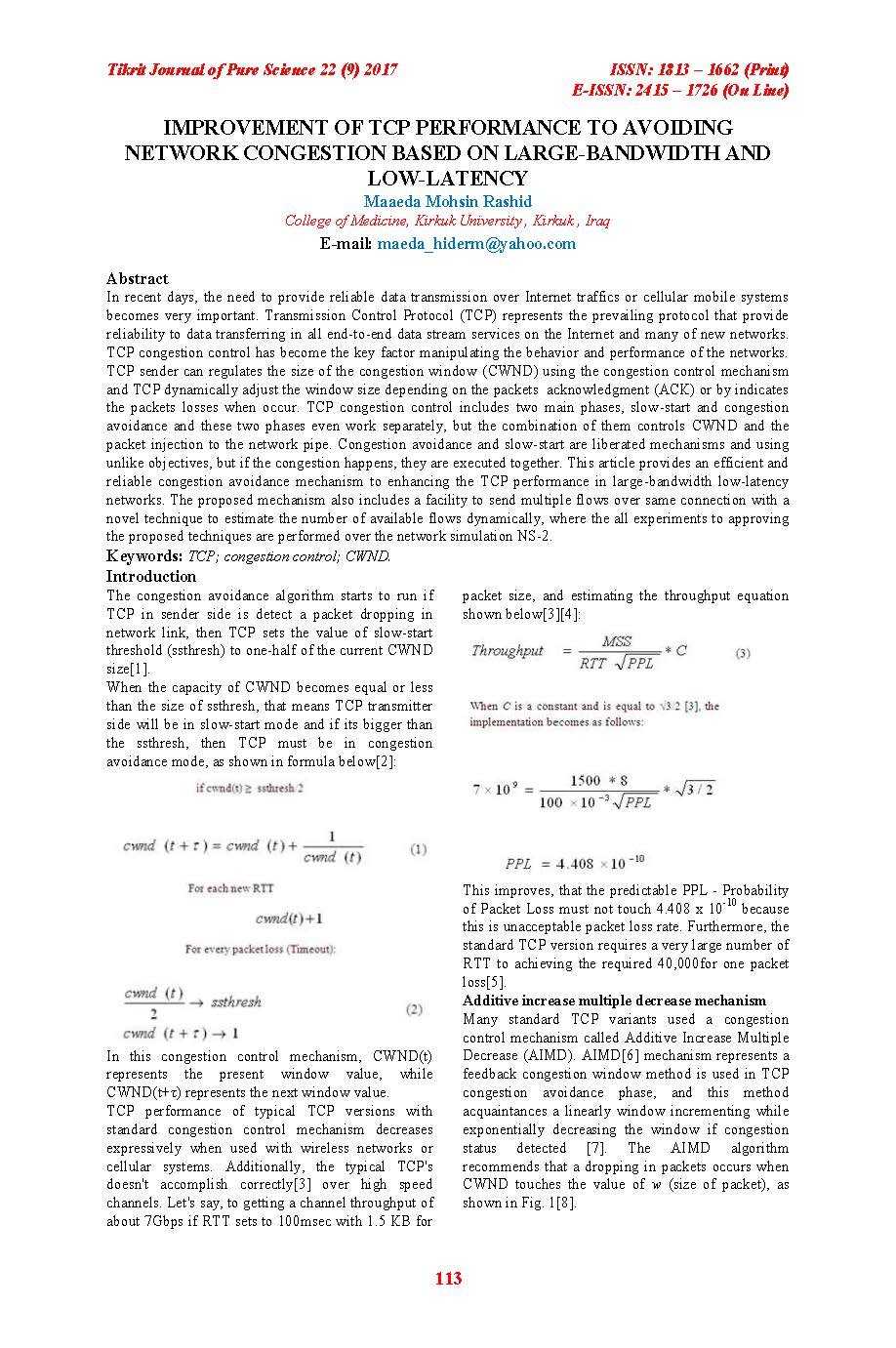K-means Clustering, Unsupervised Classification, K-NN, Euclidean Distance, Genetic Algorithm
Main Article Content
Abstract
In recent days, the need to provide reliable data transmission over Internet traffics or cellular mobile systems becomes very important. Transmission Control Protocol (TCP) represents the prevailing protocol that provide reliability to data transferring in all end-to-end data stream services on the Internet and many of new networks. TCP congestion control has become the key factor manipulating the behavior and performance of the networks. TCP sender can regulates the size of the congestion window (CWND) using the congestion control mechanism and TCP dynamically adjust the window size depending on the packets acknowledgment (ACK) or by indicates the packets losses when occur. TCP congestion control includes two main phases, slow-start and congestion avoidance and these two phases even work separately, but the combination of them controls CWND and the packet injection to the network pipe. Congestion avoidance and slow-start are liberated mechanisms and using unlike objectives, but if the congestion happens, they are executed together. This article provides an efficient and reliable congestion avoidance mechanism to enhancing the TCP performance in large-bandwidth low-latency networks. The proposed mechanism also includes a facility to send multiple flows over same connection with a novel technique to estimate the number of available flows dynamically, where the all experiments to approving the proposed techniques are performed over the network simulation NS-2.
Article Details

This work is licensed under a Creative Commons Attribution 4.0 International License.
Tikrit Journal of Pure Science is licensed under the Creative Commons Attribution 4.0 International License, which allows users to copy, create extracts, abstracts, and new works from the article, alter and revise the article, and make commercial use of the article (including reuse and/or resale of the article by commercial entities), provided the user gives appropriate credit (with a link to the formal publication through the relevant DOI), provides a link to the license, indicates if changes were made, and the licensor is not represented as endorsing the use made of the work. The authors hold the copyright for their published work on the Tikrit J. Pure Sci. website, while Tikrit J. Pure Sci. is responsible for appreciate citation of their work, which is released under CC-BY-4.0, enabling the unrestricted use, distribution, and reproduction of an article in any medium, provided that the original work is properly cited.
References
[1] Welzl M. Parallel TCP Data Transfers: A
Practical Model and its Application: University of
Innsbruck; 2010.
[2] Nabeshima M. Performance evaluation of multcp
in high-speed wide area networks. IEICE transactions
on communications. 2005;88:392-6.
[3] Mathis M, Semke J, Mahdavi J, Ott T. The
macroscopic behavior of the TCP congestion
avoidance algorithm. ACM SIGCOMM Computer
Communication Review. 1997;27(3):67-82.
[4] Fu CP, Liew SC. TCP Veno: TCP enhancement
for transmission over wireless access networks.
Selected Areas in Communications, IEEE Journal on.
2003;21(2):216-28.
[5] Ghassan A. Abed, M. Ismail, K. Jumari, Modeling
and Performance Evaluation of LTE Networks with
Different TCP Variants, World Academy of Science,
Engineering and Technology. International Journal of
Electrical, Computer, Energetic, Electronic and
Communication Engineering Vol:5, No:3, 2011.
[6] Wang J, Wen J, Zhang J, Han Y, editors. TCPFIT:
An improved TCP congestion control algorithm
and its performance2011: IEEE.
[7] Floyd S, Jacobson V. Traffic phase effects in
packet-switched gateways. ACM SIGCOMM
Computer Communication Review. 1991;21(2):26-
42.
[8] Demers A, Keshav S, Shenker S, editors. Analysis
and simulation of a fair queueing algorithm1989:
ACM.
[9] Ghassan A. Abed, Mahamod Ismail, and
Kasmiran Jumari. Improvement of TCP Congestion
Window over LTE-Advanced Networks,
International Journal of Advanced Research in
Computer Communication Engineering 1.4 (2012).
[10] Ghassan A. Abed, Mahamod Ismail, Jumari
Kasmiran, Improvement of TCP Congestion Window
over LTE-Advanced Networks, International Journal
of Advanced Research in Computer and
Communication Engineering, vol. 1, no. 4, June
2012.
[11] Raghad T. Abdulrazzaq Al-Hassani, Methodical
Improvement of Congestion Control Mechanism in
Distinctive Data Transmission, Journal of
Information, Communication, and Intelligence
Systems (JICIS), Volume 2, Issue 3, September 2016.
